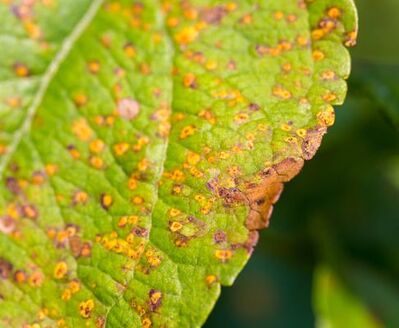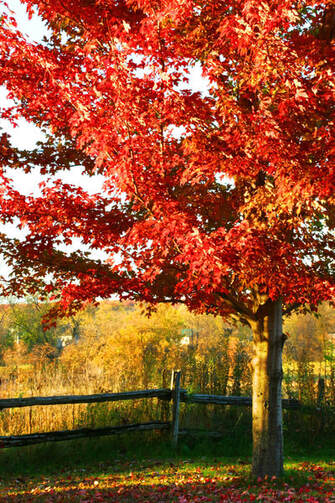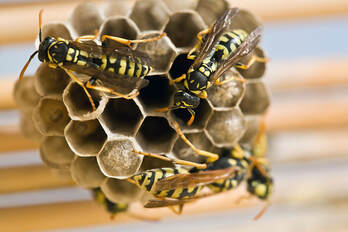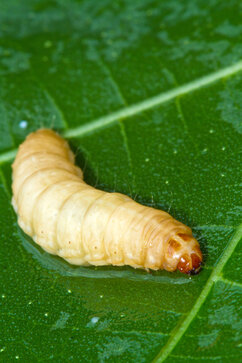|
12/16/2020 How To Treat Anthracnose Disease You may know it as twig blight or shoot. It affects a host of trees, shrubs, and other plants. Fighting an anthracnose disease can be a harrowing process, leaving homeowners asking, "How do you treat anthracnose successfully?" Realizing which plants get anthracnose and how to stop it could go a long way in efficient anthracnose control. Anthracnose Disease Information Anthracnose is a disease that tends to attack the leaves of plants in the springtime when the temperature is cool. Rainy, cold weather makes the ideal conditions for the spores to spread. Hot and dry weather halt the spread of the disease that might start again once the weather conditions become most favorable. The issue could be recurring but is hardly deadly. The sunken, dark lesions might appear on fruits, stems, and flowers. To differentiate between anthracnose and other diseases, you must inspect underneath the leaves for several brown dots around the size of a pinhead. If you aren't sure how to diagnose anthracnose disease, consult a tree care professional. Plants That Get Anthracnose A host of plants may be affected by anthracnose fungi, such as those grown outside of a greenhouse, like tropical plants and woody ornamentals. Potted plants and greenhouse crops, including palms, cyclamen, yuccas, lupine, and succulents, are affected. Trees that are susceptible to anthracnose include sycamore, walnut, maple, oak, camellia, ash, and azalea. Treating Anthracnose Anthracnose disease control starts with performing good sanitation. Get rid of all diseased plant parts, including leaves and branches, from the ground around the plant. This task stops the fungus from spreading close to the plant. Correct pruning methods to eliminate plants of dead wood also aids with stopping anthracnose fungus. Keep your plants healthy by giving the right amount of fertilizer, water, and light, strengthening the plant's ability to fight fungus attacks. Stressed plants have a hard time recuperating from anthracnose fungus. Chemical treatments aren't used except when the disease affects freshly transplanted plants or frequent defoliation. Reach out to us at Rochester Stump Removal and speak to one of our tree experts to learn more about anthracnose disease. 11/18/2020 Common Blue Spruce Diseases Colorado Blue Spruce Colorado Blue Spruce Because of its fantastic, blue-silver foliage and generous growth rate, the Colorado blue spruce tree is broadly planted throughout the U.S. This famous tree is the ideal tree for significant landscapes. Frequently, blue spruce trees become infested with tree fungal infections that affect their growth. Also, blue spruce diseases encourage damage from pests. Blue Spruce Diseases and Their Symptoms Common blue tree diseases include needle cast and canker fungus. Needle cast is a transferrable needle disease due to a fungus. Canker fungus is a disease that infects tree limbs. Symptoms of needle cast diseases are dead limbs and discolored needles. Generally, your tree looks like it's dying from the bottom upward. Diagnosing needle cast disease is done by examining the faded needles with a magnifying glass. Blue spruce trees affected with canker fungus frequently have sunken spots along a stem that might ooze resin. If you study the tree, you might also see folds of injured tissue around older canker infections. As the canker fungus spreads, it hinders the tree's capacity to transfer nutrients, resulting in dead limbs. How to Manage Tree Fungal Infections To effectively manage needle cast diseases, get rid of fallen needles and dead limbs beneath the tree to halt further infections. Also, you can spray diseased blue spruce trees with a fungicide. An insecticide application stops new viruses and safeguards new growth. It would be best if you used fungicides when the new needles extend halfway, usually in April or May. There is no cure for canker fungus. Therefore, fungicide treatments won't work. The most efficient approach is to sustain the health of your trees. Affected limbs must be trimmed in the cold months when the tree is dormant. Pruning is the primary technique of treating trees displaying signs of canker fungus. Best Disease Control Techniques As with diseases, the best control for blue spruce diseases is prevention. It's vital to know how to best maintain your tree, in terms of water, soil, and pruning obligations to successfully stop Colorado spruce issues. Soil should be fertile and well-drained. It's critical to keep the soil moist when the tree is young. Your tree must have sufficient water at all times, especially during a drought. To sustain moisture and soil quality, you can apply a mulch layer around the bottom of your tree. For more information on blue spruce diseases, contact Rochester Stump Removal. 10/14/2020 Tips On Planting Trees In The Fall There is an untrue opinion in the gardening industry that fall is the completion of the growing season. Honestly, it's quite the opposite. Planting trees in the fall is ideal for fostering good root growth. Small plants will establish themselves before the cold months arrive, getting a head start over shrubs in the springtime. Big plants will also get a head start since the rule is one inch of trunk width per year. When to Plant Trees in the Fall Autumn officially starts with the autumnal equinox at the end of September. The best time to plant trees and shrubs is around 40 days before hard frost appears. September through November is the perfect time for tree planting. When you plant a tree between these months, it lets the roots get established before the ground freezes, and winter starts. A useful suggestion is that you don't keep planting trees too late into the autumn. This technique can harm plant health. Wet, cold weather is the ideal time for tree planting. With a drop in temps and a rise in rainfall, less watering is necessary. As tree shoot growth stops, the tree necessitates less water since the days are colder and shorter. Stable air temperatures also encourage swift root development. Soils remain warm way after the air temperature cools off. Through shoot dormancy, trees develop to establish roots in new places before warm weather fuels top growth. Benefits of Fall Tree Planting There are numerous benefits to fall planting. Trees established in the autumn are more prepared to deal with the heat in the next season. Another excellent reason for fall tree planting is that you can choose your trees by the fall colors they create. If planted, protect your trees from winter winds by treating them with an anti-desiccant. Some tree types suggested for fall planting are alder, ash, linden, maple, buckeye, pine, horse chestnut, spruce, catalpa, hackberry, crabapple, hawthorn, honey locust, amur cork tree, sycamore, and elm. Call Rochester Stump Removal today to schedule a consultation with our trained tree care professionals about autumn tree planting. 9/16/2020 The Seedless Autumn Blaze Maple Tree Fast-growing, with intensely lobed leaves and fantastic fall color, An Autumn Blaze maple tree is an incredible ornamental tree. This tree unites the top qualities of their parents, silver maples, and red maples. Below are tips on caring for Autumn Blaze trees. Autumn Blaze Maple Tree Information If you believe rapid-growing trees are harmful to your outdoor space, Autumn Blaze maple trees will change your mind. These hybrids flourish over 50 feet tall without becoming susceptible to diseases, pests, or insects. Property owners growing Autumn Blaze maples will discover that the trees combine the best traits of both parents. That's one reason for the tree's popularity. Like the red maple, Autumn Blaze has an excellent balanced branching habit and comes alive with red and orange hues. It also possesses silver maple's drought endurance, lacy leaves and distinctive bark, smooth while the tree is young, but forms ridges. Growing Autumn Blaze If you are ready to begin growing Autumn Blaze maples, don't forget that the trees thrive in U.S. plant hardiness zones 3 through 8. If you live in these zones, get going. Plant these maples in the spring or autumn in an areawith lots of sunshine. Tree care is simple if the trees you plant are in moist, well-drained soil. Though, as with silver maple, Autumn Blaze maples can endure poor soil conditions. Regardless of the soil you pick, dig a hole as big as the root ball but the same depth. Put the tree's root ball so that the top is on the same level as the soil line. Caring for Autumn Blaze Maples Once you plant your maple, water it extensively to settle the roots. Next, water frequently during the first growing season. Once established, these maple trees are drought tolerant. Caring for Autumn Blaze maples isn't hard. The tree is practically seedless, so you don't have to clean up debris. One thing to think about is providing the tree with winter protection during the cold months. For more information on Autumn Maple trees, ask Rochester Stump Removal. 8/12/2020 Small Trees That Grow Well In Clay Soil Nerium Oleander Nerium Oleander Having trees that grow in clay soil can be hard unless you plant tree types that can endure compact, hard soil. Clay soil has tinier pores than sandy soil. Clay soil doesn't offer excellent drainage though some small tree types will resist those demanding conditions. Trees That Grow in Clay Soil Evergreens Some little clay-tolerant evergreen trees have an assortment of foliage types. The Guajillo grows over 10 feet high and has green leaves that look like skinny ferns. The Golden Wattle is a tall evergreen, flourishing over 20 feet high with lance-shaped leaves. The Christmas palm evergreen brings a tropical elegance to landscapes with its customary palm tree appearance. Fruit The pineapple guava tree grows over 20 feet tall and endures lousy soil conditions like clay soil. The flower petals and the fruit are edible. The black calabash fruit tree develops over 20 feet tall and generates green edible fruit. The Coppertone loquat survives in clay soil, flourishes up to 30 feet tall, and creates small orange fruit. Flowering Little trees that grow in clay soil and create showy flowers include some Nerium oleanders. These trees withstand lousy soil conditions and necessitate little water. While a couple is shrubs, others can flourish over 25 feet tall. Oleanders produce single and double flowers in yellow hues, red hues, and pink hues. The "California Glory" is a flannel bush hybrid with yellow blooms, develops over 25 feet tall, and endures many soil types, including clay. The Toyon is a drought-tolerant flowering tree that extends over 20 feet tall and produces red berries and white flowers. Deciduous Clay-tolerant deciduous trees include species like the trident maple. This little deciduous tree has traditional maple-styled leaves that become energetic yellows and reds before dropping off. Other deciduous maples include the Phoenix and fern leaf full moon maple. Even though these trees require lots of water, the evergreen dogwood grows in clay, has oval green leaves, and grows around 25 feet high. If you want more information on clay soil trees, reach out to us at Rochester Stump Removal. 7/15/2020 Trees That Grow Well In Water A Mangrove Forest A Mangrove Forest Numerous trees, including a good number of flowering and deciduous trees, flourish best in good-draining soil. Trees that grow in water, called swamp trees, are typically found in the swamps and marshes. Trees That Grow in Water Mangrove Mangrove trees grow and flourish even with their roots always engulfed in saltwater. There are a few dominant species of mangrove trees all situated in the state of Florida, the U.S. Around the globe, there are more than 45 various mangrove tree types. Mangroves are quite valuable to the coastal setting. They offer a habitat for birds and marine organisms, as well as help stop coastal erosion. Pumpkin Ash The pumpkin ash tree is a type of ash that blooms in standing water. It is referred to as pumpkin ash because the base of the trunk expands to a pumpkin-shaped figure when developing in water. This tree is along the rivers and in swamps of the Atlantic coastal plain. A quick-growing, tall tree, pumpkin ash in ash quickly grows over 120 feet. Water Tupelo The tupelo tree is in swamps and places where standing water ensues during much of the year. It resists flooded conditions quickly, as well as offering a home and food for wildlife and birds. These trees grow in the Deep South and can reach over 50 feet tall. Bald Cypress When most folks think of the Deep South swamps, they think of bare cypress trees. These massive trees, often covered with moss, have thin, long needles and can survive over 500 years old. The bald cypress is famous for its trunk, which grows "knees" at the base. The knees are part of the roots, which stick out as knob-like shapes over the water. The trees are referred to as "pneumatophores," helping the roots get oxygen from the air when the space around the tree floods. Bald cypress trees develop in both flowing and standing water. Like the tupelo tree, they are a vital source of shelter and food for wildlife. Call Rochester Stump Removal for more information on trees that develop well in water. 6/17/2020 What Is A Tree Drip Line? There are two possible definitions for tree drip line or dripline within gardening: the drip line of irrigation and the drip line in irrigation. You should realize the drip line of a tree is vital for three duties in tree care: fertilizing, watering, and mulching. Deciding the root zone where you'll apply fertilizer, lay mulch, and sprinkle water is usually the drip line of the most significant part of the canopy of the tree. Keep reading this article for more clarification. Tree Drip Line Defined The tree drip line is the place right under the outer perimeter of the tree limbs. When the tree canopy gets damp, any extra water moves to the ground along this dripline, something like an umbrella. This area is a tree's CRZ (critical root zone). Most water absorption for a tree takes place at the dripline. It would be best if you watered your trees here. If left alone, the tree can develop rot. Also, you need to water trees at the root zone, not at the bottom of the trunk, or the tree may develop root rot. You have to learn about trees. Some trees have shallow roots close to the surface. Others have deep roots that necessitate more watering that can be soaked deep down. The root zone is a storage tank of water where the tree gets its nutrients. When giving a tree fertilizing nutrients, it is vital to apply them close to the feeder rootlets. If not, the vitamins will be lost. Irrigation Drip Line Drip irrigation is a low-pressure watering system that saves fertilizer and water by letting both drips at their own pace to the roots of plants. A tree is watered and fed via a host of pipes, tubing, valves, and emitters. If you keep the roots damp but not drenched, water usage is low. Drip irrigation is when water moves through narrow tubes, so it goes right to the tree. Most gardeners prefer drip irrigation instead of surface irrigation for numerous reasons, typically including interest in reducing evaporation. The drip line is the location area for these tubes. To get assistance with your tree's drip line or to get help with watering and fertilization, contact Rochester Stump Removal. 5/13/2020 Tips For Growing Potted Pine Trees Pine trees are a significant plant type, including species that grow in various conditions and climates. Pine trees are okay with container growing. Many potted pine trees ultimately outgrow their containers, needing to be planted in your yard. You must have top-rate soil to enrich container-grown pines. Characteristics of Potted Pine Trees Pine trees necessitate a different growing method in containers than they do outdoors. The main components of a suitable container for pine trees are weight, water holding capacity, and porosity. Potted pine trees need a pot that has adequate airflow and drainage, can keep water, and is lightweight. Soilless Mixes Pine trees in containers do not use potting soil. Standard soil compacts easily and does not have enough airflow or drainage. Usually, pots contain a soil mix of peat moss and pine bark. Several ready-made potting mixes have the ingredients for a container-growing pine tree. You can also get the materials and make your own. A great place to get pine bark is your local stump grinding business. Soil pH The pH level of the soil is crucial when you pick a growing medium for pine trees. A low denotes acidic soil. A high pH signifies you have alkaline soil. Most pines like a neutral to acidic pH. Though some will also endure alkaline conditions. When you pick a container for your pine tree, make sure you consider the particular preferences of the pine tree type you expect to grow. If your tree needs acidic soil, you can reduce the pH by mixing in vast amounts of peat moss into the soil mix. Considerations For container growing, you have to give the tree all the much-needed vitamins and nutrients that you would ordinarily extract from the ground. You can achieve this by including a slow-release, well-balanced fertilizer into the growing medium before planting. Water pine trees until moist without allowing it to get waterlogged. Many pine trees flourish best in the total sun, though some types accept light shade. Contact Rochester Stump if you have questions about potted tree plants.  Yellow jackets are social wasp species famous for delivering painful stings when agitated. These pests prey on other insects. Usually, a yellow jacket nest is in a tree in the ground cavities. It isn't unusual to see a yellow jacket nest concealed near the roots of a grouping tree growing in your outdoor space. Identifying a Yellow Jacket Nest in Your Tree Yellow jackets are around the size of a fly, possessing black and yellow markings. These bugs are frequently mistaken for honeybees. However, yellow jackets are stocky and little instead of round. Several types of yellow jackets choose to build their nests near tree roots. It is vital to know that these bugs actively protect these nests when bothered. Benefits Yellow jackets are carnivorous predators that slaughter huge numbers of flies that usually bother veggie gardens and fruit trees. Adult yellow jackets attack bugs like moths, slugs, worms, caterpillars, and spiders. The preying endeavor can vastly decrease the number of bugs that could be feeding on your garden and landscape plants. Drawbacks There are drawbacks to having a yellow jacket nest in your tree. You or a loved one can become ill from a wasp sting allergy. These bugs are very protective of their nests. The vibrations from walking can get the young and queens mad and stinging. Yellow jackets get highly aggressive as their colonies increase. Therefore, most gardeners have issues with these pests when the colony peaks in autumn or summer. Stinging usually happens at the nesting site. Yellow jackets sting folks who try to slap them away from food sources like bird feeders, pet dishes, and trash cans. Management Since yellow jackets don't damage the tree itself. People, therefore, don't bother the nests, letting the yellow jackets diminish the population of harmful insects hanging around your landscape. If you need to eliminate yellow jackets, tree and stump removal professionals suggest using a pesticide spray to rid your outdoor space of hornets and wasps. Buy a product that sprays around 20 feet away. This way, you are at a safe distance while spraying right into the nest opening. Read and adhere to the directions carefully. Look at the nest the next day. If needed, reapply the insecticide. Call Rochester Stump for more information on yellow jacket nests in trees. 3/9/2020 When To Treat For Grubs In Your Yard One of the most destructive bugs in yards of any type is the white grub. White grubs are also called annual white grubs or grub worms. They destroy turf by eating the roots of the plant as well as upsetting the soil with their continuous search for eatable roots. Since these pests are so destructive, you must know when to treat for grubs. The digging by grubs is frustrating. But numerous creatures eat grubs when the grubs are active. Grubs are usually active in the late summer through autumn. When to Treat for Grub Species In North America, there are over eight species of white grubs. The accidentally introduced species are the European chafer, oriental beetle, Asiatic garden beetle, and the Japanese beetle. Most grubs have a 12-month life cycle. Some white grubs have a 24 to 36-month life cycle. A life cycle for grub is called metamorphosis. Grub Life Cycle 1. Start life as an egg, positioned in the soil 1 to 4 inches deep down 2. Eggs take in water from the surrounding soil to stay worthwhile 3. After 2 to 3 weeks, eggs hatch into tiny grubs 4. Begin eating delicate organic matter and root hairs 5. Keep feeding until early winter. As the temps fall, grubs move deeper into the soil 6. Reemerge in early spring, do some light feeding, and then pupate in the soil 7. After a couple of weeks, adult beetles surface to lay eggs, and the whole life cycle starts again Treating Grubs The time to treat for grub control is from August to June. Most of the grub control products available operate best as a preventative measure. If you want to apply the product yourself, make sure you read and adhere to label rates and directions. Grubs feed and live in the soil. Therefore, the product must be watered entirely into the ground and grass to get to the grubs. Reach out to Rochester Stump and let one of our stump removal technicians do the grub control work for you. We offer this vital service to aid in stopping grub damage to your yard. |
AuthorWrite something about yourself. No need to be fancy, just an overview. Archives
December 2020
CategoriesAll Insects & Diseases Questions & Answers Tools & Safety Trees & Landscaping Tree Stump Basics |
- Home
- Services
- About
- Contact
-
Service Areas
- Rochester NY Stump Removal
- Brighton Stump Removal
- Chili Stump Removal
- Churchville Stump Removal
- East Stump Removal
- Fairport Stump Removal
- Farmington Stump Removal
- Gates Stump Removal
- Greece Stump Removal
- Henrietta Stump Removal
- Irondequoit Stump Removal
- North Gates Stump Removal
- Parma Stump Removal
- Penfield Stump Removal
- Perinton Stump Removal
- Pittsford Stump Removal
- Victor Stump Removal
- Webster Stump Removal
- Blog
- Home
- Services
- About
- Contact
-
Service Areas
- Rochester NY Stump Removal
- Brighton Stump Removal
- Chili Stump Removal
- Churchville Stump Removal
- East Stump Removal
- Fairport Stump Removal
- Farmington Stump Removal
- Gates Stump Removal
- Greece Stump Removal
- Henrietta Stump Removal
- Irondequoit Stump Removal
- North Gates Stump Removal
- Parma Stump Removal
- Penfield Stump Removal
- Perinton Stump Removal
- Pittsford Stump Removal
- Victor Stump Removal
- Webster Stump Removal
- Blog
Search by typing & pressing enter

 RSS Feed
RSS Feed